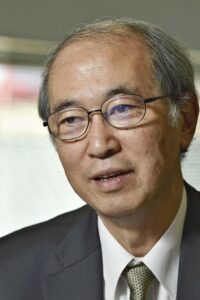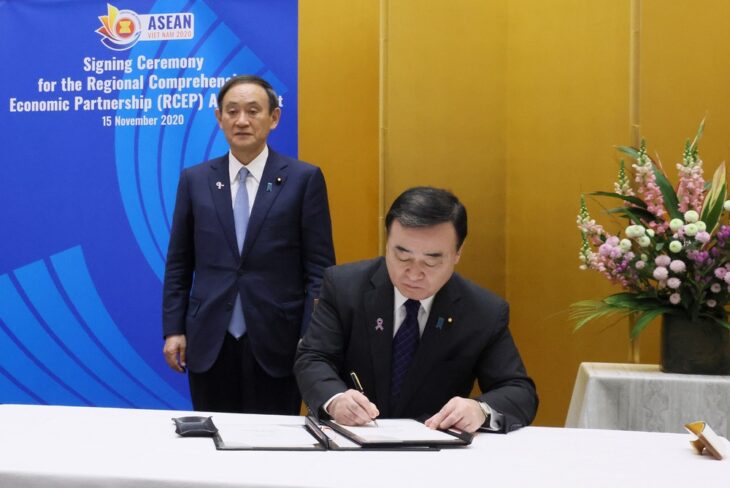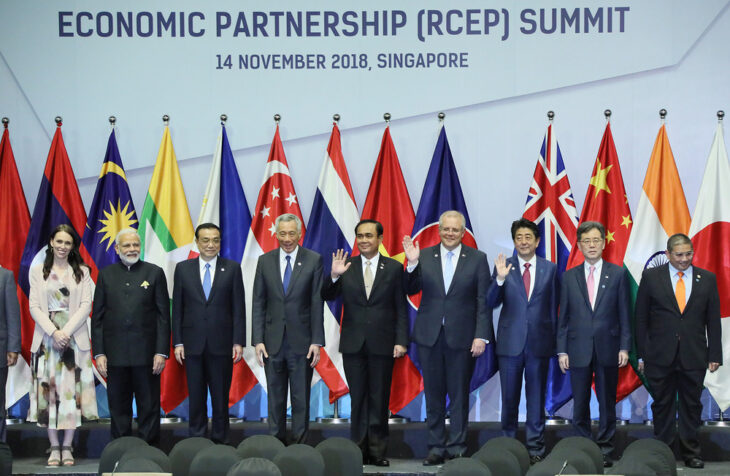The Growing Role of Japan in Economic Integration in the Asia-Pacific Region as US Involvement Declines
Urata Shujiro, Professor Emeritus, Waseda University
The RCEP Has Finally Been Signed

Prof. Urata Shujiro
On November 15, 2020, fifteen East Asian countries including Japan, China, South Korea, the Association of Southeast Asian Nations (ASEAN), Australia and New Zealand signed the Regional Comprehensive Economic Partnership (RCEP). The RCEP negotiations were launched in May 2013 by sixteen countries, the fifteen mentioned above and India, but the negotiations ran into problems. The deadline for signing the agreement was updated many times and India even withdrew from the negotiations, but after seven years, a signed agreement has now finally been achieved. The RCEP is a comprehensive agreement consisting of trade and investment liberalization as well as rules for intellectual property and electronic commerce. Since many countries, including the principal ones, are among the member nations, the RCEP is also referred to as a mega free trade agreement (FTA).

On November 15, the Minister of Economy, Trade and Industry Kajiyama Hiroshi signed the Agreement alongside representatives of 14 other countries with the presence of Prime Minister Suga Yoshihide (Minister for Foreign Affairs Motegi Toshimitsu separately co-signed the Agreement beforehand).
Photo: Cabinet Public Relations Office
The RCEP is often compared with the Comprehensive and Progressive Agreement for Trans-Pacific Partnership (CPTPP, or TPP11), which is a mega FTA that came into effect in March 2018, with eleven Asia-Pacific countries, including Japan, Australia and Canada, among its member nations. The negotiations of the Trans-Pacific Partnership (TPP), which is the prototype for the CPTPP), were initiated in March 2010 and the agreement was signed in November 2016. There were twelve signatories, including the United States, to the TPP, but in January 2017, President Trump withdrew the United States from the TPP. Subsequently, the remaining eleven member nations formed the CPTPP. China participated in the negotiation stages of the RCEP, but the United States did not. On the other hand, the United States participated in the TPP and China did not, so the RCEP and TPP were discussed in the context of conflict between the US and China.
This paper examines the negotiation process, the contents of the agreement, the motivations of the member nations, the impact on the international economy, and international relations with regard to the RCEP and TPP (CPTPP), which will play an important role in building a framework for trade and investment in the Asia-Pacific region (regional economic integration). Based on these examinations, I would like to discuss the significance of regional economic integration in the Asia-Pacific region and Japan’s role in its realization.
The Battle Between Japan, China and the United States over the Leadership of Regional Economic Integration in the Asia-Pacific
The origin of the RCEP can be traced back to the Asian financial crisis in 1997–98. At the ASEAN+3 (Japan, China and South Korea) Summit Meeting in 1998, South Korean President Kim Dae-jung proposed to the East Asian countries finding themselves in difficulties due to the crisis to set up the East Asia Vision Group (EAVG) with the aim of examining economic cooperation to recover from the crisis and to avoid a recurrence. The EAVG held discussions and submitted policy proposals, including the construction of the East Asia Free Trade Area (EAFTA), to the leaders in 2002. In 2005, a research group consisting of private-sector experts began examining the feasibility of the EAFTA. In 2009, the EAVG compiled a report which recommended the start of government-level study.
In 2006, after the establishment of the EAVG, Japan proposed the Comprehensive Economic Partnership in East Asia (CEPEA) with a membership composed of the ASEAN+3+3 (ASEAN10, Japan, China, South Korea, India, Australia, New Zealand). Since China had played a leading role in the EAFTA discussions, the strategic intention behind the Japanese proposal was for Japan to play a leading role in the regional integration of East Asia and to curb China’s influence by welcoming the democracies of India, Australia and New Zealand. Similarly to the EAFTA process, a research group of private-sector experts was set up to examine the feasibility of CEPEA. The research group submitted a similar report at the same time as the EAFTA. Subsequently, the governments of the countries concerned established a working group to start to examine the contents of the EAFTA and CEPEA, but the work did not progress much.
While the East Asian countries discussed regional-level FTAs, several countries participating in the Asia Pacific Economic Cooperation (APEC) began to discuss forming regional FTAs that would include a high level of trade liberalization. This was the situation when Chile, Singapore and New Zealand started negotiations in 2002. Subsequently, Brunei joined the negotiations. In 2006, the P4 Agreement between these four countries took effect. In 2008, the P4 member countries began negotiations to expand the P4 to promote liberalization of financial services and investment. In 2009 under the Obama administration, the United States, which was interested in liberalizing financial services and investment, announced that it would join the negotiations. The P4 was renamed the TPP around that time. In 2010, negotiations to expand the TPP began when Australia, Peru and Vietnam also joined. Fearing exclusion from the East Asian market, the United States was prompted to join the TPP, which encompasses the Trans-Pacific region, when emergence of discussions about regional-level FTAs in East Asia emerged. In fact, seeking to maintain access to the East Asian market, the United States proposed the Free Trade Area of the Asia Pacific (FTAAP), which consists of APEC members, in 2006.
Japan announced its intention to join the TPP negotiations in 2010, but strong opposition from the agricultural sector made participation difficult. Since the possibility of Japanese participation in the negotiations emerged as the TPP negotiations moved forward, China, which feared that an FTA without Chinese participation would be formed in the Asia-Pacific, joined with Japan in 2011 to propose the establishment of a working group aimed at implementing the EAFTA and the CEPEA, the motivation being to promote regional integration without the United States in the form of either the EAFTA or the CEPEA. In the same year, the ASEAN, which had taken it for granted that it would play a central role in the regional integration of East Asia, proposed the RCEP, a framework that is not limited to specific member states such as ASEAN+3 or ASEAN+6, to counteract the joint proposal by Japan and China. The RCEP proposal was accepted and the start of negotiations was announced at the 2012 ASEAN+6 Summit Meeting, but the actual negotiations did not begin until May 2013.
The RCEP negotiations were triggered by Japan’s participation in the TPP negotiations. Back in power at the end of 2012, Prime Minister Abe Shinzo overcame opposition from the agricultural sector on condition that he would maintain protection for five sensitive agricultural products including rice, wheat and beef. In March 2013, Japan announced that it would participate in the TPP negotiations. Triggered by the announcement of Japan’s participation in the TPP negotiations, 2013 saw a chain reaction of FTA negotiation starts including the Japan-China-South Korea FTA in March, the Japan-EU EPA in April, the RCEP in May, and the Transatlantic Trade and Investment Partnership (TTIP) between the United States and the EU in July. While the principal countries pursued leadership positions in regional economic integration, the trend for “competitive regionalism” was triggered by the fear of being left behind in the wave of regional integration.
RCEP and TPP: Competitive or Complementary?
Seven countries, including Japan, Australia and Singapore, participate in both the RCEP and TPP frameworks, but it is often said that the two frameworks are in a competitive relationship since the participating countries are different. But is this really the case? Specifically, China only participated in the RCEP and the United States only participated in the TPP up to the stage of signing the agreement before eventually withdrawing.
Let’s start with a comparison of the items included under the RCEP and TPP. The agreements are comprehensive. They do not only cover items that are subject to World Trade Organization (WTO) rules such as the goods and services trade, investment, Sanitary and Phytosanitary Standards (SPS), and intellectual property rights, but they also include items that are not covered by the WTO such as electronic commerce and competition policy. However, while some items are included under the TPP but not the RCEP, there are also items that are included under both agreements, but treated more leniently under the RCEP than the TPP.
State-owned enterprises and labor are focal points among items included in the TPP, but not in the RCEP. The TPP stipulates that state-owned enterprises should be treated in the same way as private enterprises and foreign enterprises, and prohibits subsidies and other government incentives. Where labor is concerned, the TPP obliges nations to adopt in their own laws the basic principles and rights of labor stipulated by the International Labor Organization (ILO), such as prohibition of forced labor and child labor, and elimination of discrimination with regard to employment and occupation. Such rules are supposedly difficult to adopt in China and some other RCEP member countries.
Even when the same items are included under both agreements, the trade in goods and services, and electronic commerce, among others, is more loosely regulated under the RCEP than the TPP. The rate of tariff elimination, which indicates the proportion of items for which tariffs are eliminated to total imported items, is used as an indicator to measure the degree of commitment to liberalizing the trade in goods in FTAs. Under the TPP, the rate of tariff elimination is 100% in almost all participating countries. Under the RCEP, Singapore is the only country at 100% while the rate for the least developed countries in the ASEAN, including Cambodia, Laos and Myanmar, is below 90%. Even in Japan, Australia, New Zealand, Malaysia, Vietnam, and other countries participating in both agreements, the rate of tariff elimination rate under the RCEP is lower than under the TPP.
Concerning agreements to liberalize the services trade, there is the negative list approach, which specifies the categories where rules do not apply, and the positive list approach, which specifies the categories where rules do apply. Under the TPP, all countries have adopted the stricter negative list approach, but under the RCEP, eight countries (Cambodia, Laos, Myanmar, Philippines, Thailand, Vietnam, China and New Zealand) have adopted the positive list approach for specific areas. However, after the agreement takes effect, countries are obliged to shift to the negative list approach within three years (Cambodia, Laos; within twelve years for Myanmar). Regarding electronic commerce, the TPP prohibits the requests for transfer of source codes for mass-market software and for access to the source code, but there is no such prohibition under the RCEP.
Based on the above comparison, we see that the RCEP and TPP are in a competitive relationship from the perspective of the participating countries, but complementary in terms of content. Since the TPP has stricter rules about liberalization than the RCEP, participation is difficult for countries with high levels of government involvement in the economy and for the least developed countries with immature markets. In fact, all participating nations are treated equally under the TPP, while support for the economic development of the least developed countries is an important objective under the RCEP, which gives preferential treatment to the least developed countries. Regarding the relationship between the RCEP and TPP, it is evident that countries in the early stages of economic development, which find it difficult to adopt the advanced economic liberalization rules, participate in the RCEP to advance their economic development. Once their economies have developed and they are able to accept advanced rules, they join the TPP. At the APEC Summit held in Yokohama in 2010, it was agreed that the ultimate goal for regional economic integration in the Asia-Pacific is the FTAAP, and that the EAFTA, CEPEA and TPP map out the route to establishing the FTAAP. Since the EAFTA and CEPEA have subsequently been integrated in the form of the RCEP, the RCEP and the TPP are now the route toward establishing the FTAAP.
Japan-China-US Motivation with Regard to the RCEP and TPP
Since the RCEP and TPP are FTAs that reduce or eliminate barriers to trade and investment among participating countries, the members expect to promote economic growth by expanding direct investment and exports to other participating countries. However, negotiations are difficult because expanding imports from other participating countries under FTAs may damage domestic industries and employment. In fact, the RCEP and TPP negotiations were protracted because of opposition to liberalization. On the other hand, countries that are excluded from FTAs will suffer because of loss of opportunities to expand exports and direct investments. FTAs also have important implications for international affairs and politics. FTAs are often concluded as one of the means to develop closer international relations with specific countries.
In this section, I would like to explore the motivations of Japan, China and the United States with regard to the RCEP and TPP in view of the above-mentioned impact of participation or non-participation in FTAs. Since the RCEP and TPP negotiations were protracted, each country probably changed its motivation during the negotiation period, but the discussion will focus on the final phase of the negotiations when the motivations of each country were clearly expressed.
China
For China, the RCEP is a very important regional framework that facilitates economic expansion into East Asia. Since 2017, in particular, the RCEP has become more significant as the restrictions on exports to the United States due to the trade war and decoupling imposed by President Trump have placed China in a difficult situation. China launched the Belt and Road Initiative (BRI) in 2013, which aims to build an economic zone from China to the West through Southeast Asia, South Asia, Middle East, Africa and Europe by constructing infrastructure. Since the RCEP is seen as an economic zone extending from China to East Asia, including Japan, South Korea and Australia, it is an important framework for building a major economic zone centered on China and connecting Asia to Europe.
China hopes that its involvement in the formation of the RCEP will be assessed as promoting free trade in a world economy where protectionism is on the rise. In addition, as President Trump turns inward under the America First policy, China sees an opportunity to expand its influence in the Asia-Pacific and to drive a wedge between the United States and its allies such as Japan and Australia. In fact, at the APEC Summit Meeting after the RCEP agreement had been concluded, President Xi Jinping made it clear that China was keenly interested in the CPTPP, which did not include the United States. Amid calls among CPTPP participants for the United States to return to the CPTPP after the shift from the Trump administration to the Biden administration in the United States, China is motivated to join the CPTPP before the return of the United States. However, at present, China’s participation in the CPTPP is complicated because it is difficult for China to accept many of the rules under the CPTPP, including those that apply to state-owned enterprises and labor.
Since the RCEP is an extremely important framework for China, there is a view that the RCEP negotiations were led by China. Certainly, the economic scale of China is the largest among the RCEP participants and China had an important role in the RCEP negotiations because the participating countries are highly dependent on the economic aspects such as trade with China, but it is highly probable that the ASEAN led the negotiations. In the first place, the RCEP framework is based on a proposal by the ASEAN. In addition, the RCEP Ministerial Meetings, which played an important role in the negotiations, were held in ASEAN countries, suggesting that the ASEAN was at the helm.
Japan

On November 14, 2018, then Prime Minister Abe Shinzo attend the 21st Japan-ASEAN Summit Meeting and RCEP) Summit held in Singapore. Prime Minister Abe stated that, in the context of rising protectionist sentiments, the strategic importance of the RCEP is further growing, and that a free, fair and rule-based market should be established for the realization of the free and open Indo-Pacific.
Photo: Cabinet Public Relations Office
The RCEP is of great economic significance for Japan. By creating a free trade framework with China and Korea, respectively Japan’s second and third largest export destinations after the United States, Japan can expect to increase exports to both countries. In addition, when rules for the service trade, investment, intellectual property, government procurement, electronic commerce, and other areas are established, the activities of Japanese companies in the East Asian region will expand. In particular, having suffered much damage from unfair trade practices such as forced technology transfer requests and infringement of intellectual property rights when expanding to China, Japanese companies will benefit greatly from the suppression of such unfair trade practices under the RCEP. Through the Japan-ASEAN Comprehensive Economic Partnership Agreement, Japan has established a trading and investment environment that encourages the establishment of supply chains with the ASEAN, but the RCEP has created an environment that facilitates the construction of supply chains with China and South Korea in addition to the ASEAN. The results of simulation analysis at the Peterson Institute for International Economics in the United States have confirmed that participation in the RCEP is likely to be a driving force for growth in the Japanese economy. According to the analysis, Japan and Korea had the highest national income increase of 1% among the countries participating in the RCEP. Incidentally, China was at 0.3% and other participating countries at about 0.5%.
Japan has missed out on opportunities to reap greater benefits from the RCEP. Firstly, there is the continuation of agricultural protection. For political reasons, it is difficult to liberalize Japan’s agricultural sector, so protection remained on the table during both the RCEP and the TPP negotiations. The efficient use of labor and capital is indispensable to drive economic growth in a society with a rapidly dwindling birthrate and aging population. Therefore, it is necessary to shift labor and capital, which are used inefficiently under protection, to more productive sectors through liberalization, but this could not be done. The other point is India’s withdrawal from the RCEP. With the world’s second largest population after China, India is not only a huge market, but its competitive digital sector can also play an important role in supply chains. Thus, India’s participation in the RCEP would have had a great effect on growth not only in Japan, but also in other participating countries. In addition, Japan, along with Australia and other democracies, expected India to counterbalance the rise of China. However, fearing damage from trade liberalization due to participation in the RCEP, India withdrew at the final stage of the negotiations. India has left the RCEP, but Japan is trying to maintain India’s involvement with regional integration in the Asia-Pacific by actively promoting the Free and Open Indo-Pacific (FOIP) Initiative with India as an important member, which was first introduced by then Prime Minister Abe in 2016.
United States
The United States has had a keen interest in maintaining and strengthening its economic relationship with the fast-growing East Asian region since the 1990s. A founding member of APEC, established in 1989, the United States hosted the APEC in Seattle in 1993 when the APEC was upgraded from a ministers meeting to a summit meeting. The United States proposed the FTAAP in 2006 and participated in the TPP negotiations in 2010. The United States played a central role in the TPP negotiations and made significant contributions to the conclusion of the negotiations. In terms of context, the aim was not only to achieve high growth rates by expanding trade and investment through a highly disciplined agreement, but also to block China’s rapid catch-up by excluding China, which had leveraged unfair trade practices to maintain high growth. In addition, the United States was also interested in exerting influence on the reconstruction of the dysfunctional World Trade Organization (WTO) by playing a central role in the formation of regional frameworks in the Asia-Pacific, a major part of the world economy.
When President Trump took office in 2017, he extinguished US interests in the TPP and APEC. Advocating an America First principle, he believed that US interests could be maximized in bilateral frameworks, such as the US-Mexico or the US-Canada frameworks, rather than in multilateral frameworks such as the TPP. The United States as a whole was committed to protectionism with Hillary Clinton, who lost the election to Trump, also opposed to the TPP. Believing that the huge trade deficit with China was robbing the United States of jobs, President Trump launched a trade war by raising tariffs significantly to curb imports from China. As the United States turned inward and lost interest in the Asia-Pacific, China was steadily expanding its presence in the Asia-Pacific by advancing the BRI and playing an important role in the RCEP. China has also taken a strong interest in the TPP where the United States led the negotiations with the containment of China as one of the important objectives.
In November 2020, Biden defeated Trump in the presidential elections and was inaugurated as President in January 2021. President Biden has stated that he will change the America First policy and pursue foreign policy in collaboration with foreign countries. However, the top priorities are domestic economic issues and COVID-19 countermeasures, so it is not likely that there will be any new developments in foreign economic policy for the time being. Faced with the COVID-19 pandemic, a once-in-a-century crisis, it is only natural that the response to the domestic economy and society is of the highest priority, but it is also necessary to move forward the discussions with Japan, Australia and Singapore, who have shared interests in the economic strategy for the Asia-Pacific region, which is undergoing major changes due to the signing of the RCEP, the CPTPP taking effect, and progress with the BRI.
The Role of Japan in Regional Integration in the Asia-Pacific
For Japan, which cannot expect to grow its domestic market amid a dwindling birthrate and aging population, economic exchanges through trade and investment with the Asia-Pacific region, where high growth is expected, are critically important to achieve economic growth. For Japanese companies, the Asia-Pacific offers opportunities to expand their business through exports and foreign direct investment. Meanwhile, the Japanese economy will be revitalized and grow by accepting imports and investments from the Asia-Pacific region.
A free, open, transparent, fair and stable rule-based trade and investment environment is essential to implement the kind of active trade and investment exchanges that will benefit the Japanese economy. It is the responsibility of the WTO to develop and manage such a trade and investment environment, but the WTO has not been able to fulfill its expected role due to differences in opinions among the WTO member countries. In such situations, regional arrangements such as the CPTPP and the RCEP play an important role. Although the CPTPP has come into effect, the agreement has not yet been ratified by all signatory nations. It is important that all signatories participate and that the ratification process for all the members is completed as soon as possible. The RCEP has been signed and member states are currently in the process of ratification. It is important to complete ratification and for the framework to take effect as soon as possible.
The challenge for both the CPTPP and the RCEP is to expand the membership. Since damage caused by exclusion increases as the number of countries participating in the FTA rises, the number of countries wishing to participate will rise. In fact, the UK and South Korea are reportedly keenly interested in joining the CPTPP. China has also shown interest, but the partnership must resolutely maintain strong rules since it is possible that China may demand flexible treatment with regard to participation. In terms of new members, the United States is expected to join the CPTPP, and India the RCEP.
In the future, the RCEP is expected to increase and improve discipline and to integrate with the TPP to realize the FTAAP. In a situation where the two major powers of the United States and China are in conflict, Japan, which is the world’s third largest economic power and has close ties with both the United States and China, can play a leading role in the formation of a regional framework in Asia-Pacific. Playing such a role would contribute to the economic growth and prosperity of Japan, the Asia-Pacific region, and the world.
The Biden administration, which has been inaugurated in the United States, is now steering its foreign policy in the direction of actively promoting cooperation with other countries rather than going it alone. In the short term, participation in the CPTPP is difficult due to domestic circumstances. Given this situation, Japan should lead discussions with the United States on future regional integration, such as the FTAAP, while collaborating with Australia, New Zealand, Singapore, and other countries that share Japan’s interests. Fortunately, Japan chairs the CPTPP presidency this year, while New Zealand chairs the APEC. I would like to see the government of Japan advance the discussion by seizing this opportunity to carefully formulate a strategy for the realization of regional integration in Asia-Pacific.
Translated from an original article in Japanese written for Discuss Japan. [March 2021]
Keywords
- Urata Shujiro
- Waseda University
- mega free trade agreement
- FTA
- Regional Comprehensive Economic Partnership
- RCEP
- Comprehensive and Progressive Agreement for Trans-Pacific Partnership
- CPTPP
- TPP11
- East Asia Vision Group
- EAVG
- East Asia Free Trade Area
- EAFTA
- Comprehensive Economic Partnership in East Asia
- CEPEA
- Free Trade Area of the Asia Pacific
- FTAAP
- World Trade Organization
- WTO
- International Labor Organization
- ILO
- Belt and Road Initiative
- BRI




